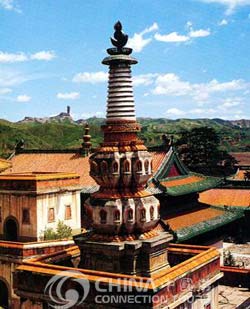
 On the east and north of Imperial Summer Resort there are twelve colorful, attractive, magnificent and glorious grand Lamaism temples that are encircled by waving mountains just as the moon was surrounded by plenty of stars. These temples are models of the Hans, Mongols, Tibetan temples. From them we can see and feel the grandness of Potala Palace in Tibet, the magnificence of Tashilhunbu Monastery, the elegance of Shuxiang Temple on Wutai Mountain, the beauty of Guerzha Temple of Yili in Xinjiang and the world wonder -the largest Bodhisattva made of wood in the world which has thousands of hands and thousands of eyes. At that time eight temples of them were managed by the government of the Qing Dynasty and registered in Beijing Lama Publishing and Registration Council.
On the east and north of Imperial Summer Resort there are twelve colorful, attractive, magnificent and glorious grand Lamaism temples that are encircled by waving mountains just as the moon was surrounded by plenty of stars. These temples are models of the Hans, Mongols, Tibetan temples. From them we can see and feel the grandness of Potala Palace in Tibet, the magnificence of Tashilhunbu Monastery, the elegance of Shuxiang Temple on Wutai Mountain, the beauty of Guerzha Temple of Yili in Xinjiang and the world wonder -the largest Bodhisattva made of wood in the world which has thousands of hands and thousands of eyes. At that time eight temples of them were managed by the government of the Qing Dynasty and registered in Beijing Lama Publishing and Registration Council.
The temples were built between the years 1713 and 1780 under emperors Kangxi and Qianlong, and are clustered along the northern and eastern sides of the Imperial Palace. The significance is that the Eight Temples symbolize the various ethnic groups from all parts of China directing their loyalty toward the center of authority. In addition, the Eight Temples were built with attractive, fresh and beautiful color such as colored glaze tiles and gold-plating scale roof; they look really spectacular and marvelous. In that historic situation, that comes to the purpose of "to defend frontier, to unit hearts of inner side and outer side and to make the country stable" and gets to the effect of "One temple in Qing Dynasty was more powerful than thousands of soldiers". The remaining inscriptions and cultural and cultural exchange among different nationalities at the beginning of Qing Dynasty and showed the historical process of unity, consolidation and development of the multinational country.

